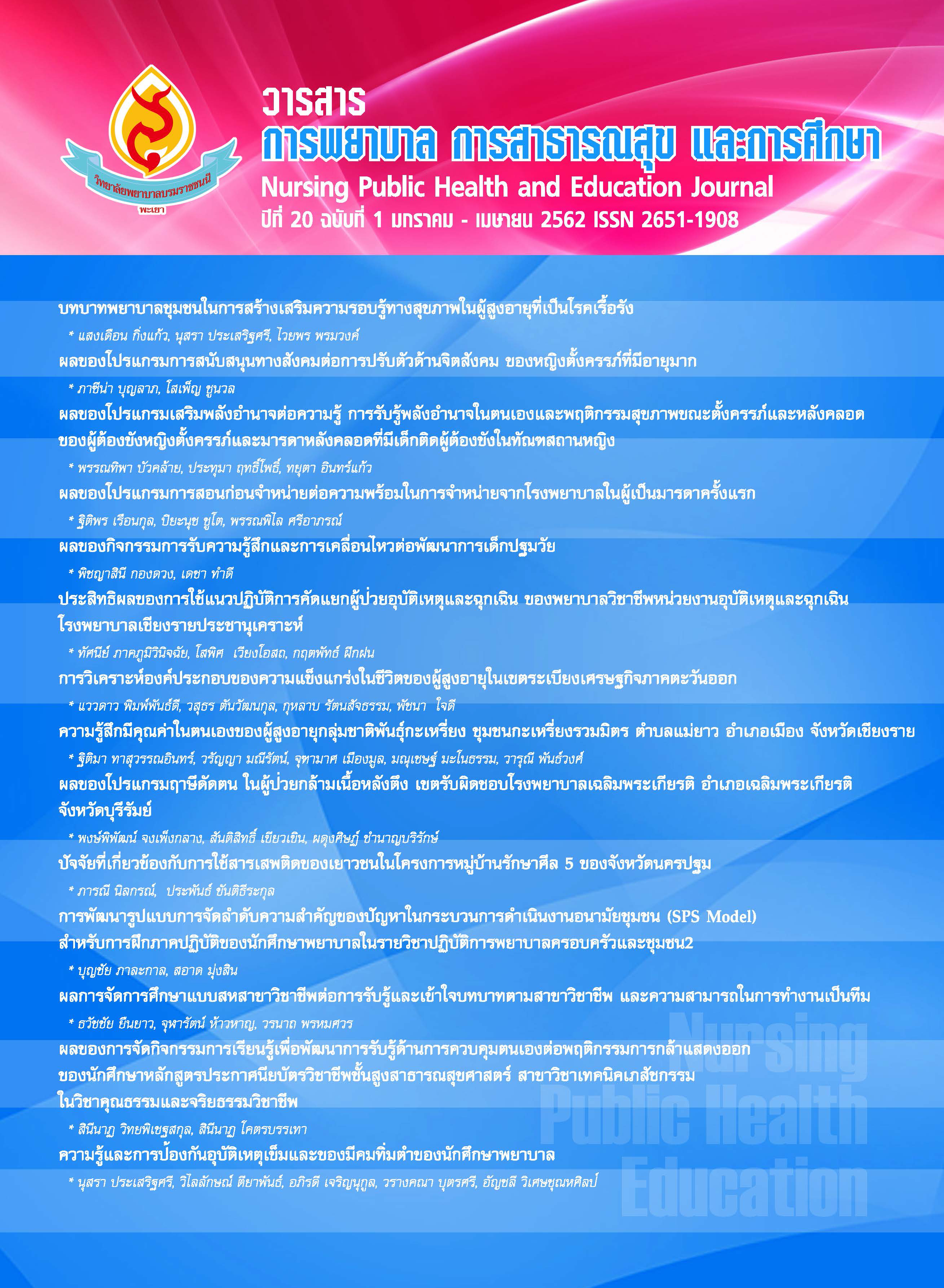ผลของโปรแกรมการสอนก่อนจำหน่ายต่อความพร้อม ในการจำหน่ายจากโรงพยาบาลในผู้เป็นมารดาครั้งแรก
คำสำคัญ:
การสอนก่อนจำหน่าย, ความพร้อมก่อนจำหน่ายจากโรงพยาบาล, ผู้เป็นมารดาครั้งแรก, Discharge teaching, Readiness for hospital discharge, First-time mothersบทคัดย่อ
ระยะหลังคลอดเป็นช่วงที่มีการเปลี่ยนแปลงอย่างมากมายทั้งด้านร่างกายและจิตสังคม หากมารดาไม่มีความรู้และทักษะในการดูแลตนเองและทารก อาจทำให้เกิดปัญหาสุขภาพตามมาได้ การวิจัยกึ่งทดลองครั้งนี้มีวัตถุประสงค์เพื่อศึกษาผลของโปรแกรมการสอนก่อนจำหน่ายต่อความพร้อมในการจำหน่ายจากโรงพยาบาลใน ผู้เป็นมารดาครั้งแรก กลุ่มตัวอย่างคือมารดาหลังคลอดครรภ์แรกที่พักฟื้นในหอผู้ป่วยหลังคลอด ณ โรงพยาบาลพะเยา จำนวน 52 ราย เลือกกลุ่มตัวอย่างตามคุณสมบัติที่กำหนด แบ่งเป็นกลุ่มทดลองและกลุ่มควบคุม กลุ่มละเท่าๆ กัน โดยกลุ่มทดลองได้รับโปรแกรมการสอนก่อนจำหน่ายจากพยาบาลผดุงครรภ์ ส่วนกลุ่มควบคุมได้รับการเตรียมความพร้อมก่อนจำหน่ายตามที่เคยปฏิบัติเครื่องมือที่ใช้ในการดำเนินการวิจัย ได้แก่โปรแกรมการสอนก่อนจำหน่าย ประกอบด้วย แผนการสอนก่อนจำหน่ายในผู้เป็นมารดาครั้งแรกที่ผู้วิจัยสร้างขึ้นตามกรอบแนวคิดของไวส์และเพียเซ็นต์ทีน (2006) คู่มือการเตรียมความพร้อมในการจำหน่ายจากโรงพยาบาลสำหรับมารดาหลังคลอดภาพสไลด์ประกอบคลิปวิดิโอตุ๊กตาทารกและหุ่นเต้านมจำลองเครื่องมือในการเก็บรวบรวมข้อมูล ได้แก่ แบบบันทึกข้อมูลส่วนบุคคลของมารดาและทารก แบบวัดความพร้อมในการจำหน่ายจากโรงพยาบาลของไวส์และ เพียเซ็นต์ทีน (2006) ฉบับภาษาไทยโดย ศิริรัตน์ ปานอุทัย (2557)เครื่องมือทั้งหมดได้ผ่านการตรวจสอบความตรงเชิงเนื้อหาจากผู้ทรงคุณวุฒิ 5 ท่าน หาค่าความเที่ยงของแบบวัดความพร้อมในการจำหน่ายจากโรงพยาบาลโดยใช้ค่าสัมประสิทธิ์แอลฟาครอนบาคได้เท่ากับ .94 วิเคราะห์ข้อมูลด้วยสถิติพรรณนาและสถิติทดสอบค่าทีชนิดสองกลุ่มอิสระจากกัน ผลการวิจัยพบว่า ความพร้อมในการจำหน่ายจากโรงพยาบาลของกลุ่มทดลองมากกว่ากลุ่มควบคุมอย่างมีนัยสำคัญทางสถิติ (P <.001) ผลการวิจัยครั้งนี้เสนอแนะว่า พยาบาลผดุงครรภ์ควรนำโปรแกรมการสอนก่อนจำหน่ายไปใช้กับผู้เป็นมารดาครั้งแรก เพื่อให้มีความพร้อมในการจำหน่ายออกจากโรงพยาบาลเพิ่มมากขึ้น
Effect of Discharge Teaching Program on Readiness for Hospital Discharge Among First-time Mothers
The postpartum period is a period of great change both physically and psychosocially. Health problems may occur if mothers don’t have the knowledge or skills to care for themselves and their newborns. This quasi-experimental research study aimed to examine the effect of a discharge teaching program on readiness for hospital discharge among first-time mothers. The participants were 52 first-time mothers admitted to the postpartum ward at Phayao Hospital. The participants were selected based on the study inclusion criteria and were assigned in equal numbers into an experimental or a control group. Participants in the experimental group received the discharge teaching, while participants in the control group received routine care. The interventional instruments were Discharge Teaching Programs including Discharge Teaching Plan developed by the researcher based on model by Weiss and Piacentine(2006),Discharge teaching manual guidebook for postpartum mothers, power point media with VDO clip, baby doll and breast model. The data collection instruments were personal information for postpartum mothers and baby questionnaire. The Readiness for Hospital Discharge Scale also by Weiss and Piacentine (2006), Thai version by SiriratPanuthai (2014). All instruments were validated by 5 experts. The reliability of Readiness for Hospital Discharge Scale was tested using Cronbach’s alpha coefficient yielding a value of .94. Data were analyzed using descriptive statistics and an independent t-test. The study revealed that the experimental group was significantly more ready for discharge than the control group. (P <.001). This finding suggests that nurse - midwives should provide the Discharge Teaching Program to help first - time mothers to be ready to discharge from the hospital.
เอกสารอ้างอิง
สนับสนุนทางสังคมต่อความเครียดของมารดาหลังคลอด, วารสารวิชาการมหาวิทยาลัยการจัดการและ เทคโนโลยีอีสเทิร์น , 11(1), 1 - 11.
2. กองยุทธศาสตร์และแผนงาน สำนักงานปลัดกระทรวงสาธารณสุข กระทรวงสาธารณสุข. (2560).
สรุปสถิติที่สำคัญ พ.ศ. 2560 Statistical Thailand. นนทบุรี: กระทรวงสาธารณสุข.
2. ปรียกมล ไกรกิจราษฎร์, กรรณิการ์ กันธะรักษา, เสาวนีย์ เหลี่ยมไตรรัตน์ และ บุษกร
จันทร์จรมานิตย์. (2559). ปัจจัยทำนายความพร้อมสำหรับการจำหน่ายออกจากโรงพยาบาลของมารดาหลังคลอด. กำลังพิมพ์.
3. ไพลิน ถิระวัฒน์, จิราภรณ์ ฉลานุวัฒน์ และนุสสรา วิญญาณ. (2555). ผลการใช้โปรแกรมเสริมทักษะ “คุณแม่มือใหม่ใส่ใจลูกรัก” ในการดูแลทารกแรกเกิดของมารดาครรภ์แรก
โรงพยาบาลพุทธโสธร. วารสารกองการพยาบาล, 39(1), 63 – 78.
4. มัทนา สังวาลย์และนิตยา โรจนนิรันดร์กิจ. (2558). การศึกษาเปรียบเทียบประสิทธิผลของสื่อการสอนระหว่างสื่อวิดิทัศน์กับภาพพลิกในด้านความรู้เรื่องการปฏิบัติตัวหลังคลอดและทักษะการให้นมมารดาของสตรีหลังคลอด. วารสารพยาบาลสาธารณสุข, 29(1), 56 - 66.
5. ศักรินทร์ ชนประชา. (2557). ทฤษฎีการเรียนรู้ผู้ใหญ่: สิ่งที่ครูสอนผู้ใหญ่ต้องเรียนรู้. วารสาร
ศึกษาศาสตร์ มหาวิทยาลัยสงขลานครินทร์ วิทยาเขตปัตตานี. 25(2). 13 – 21).
6. อัญญา ปลดเปลื้อง, อัญชลี ศรีจันทร์ และสัญญา แก้วประพาฬ, (2559) ผลของโปรแกรมการส่งเสริมการเลี้ยงลูกด้วยนมแม่โดยการสนับสนุนของครอบครัวต่อความรู้ ทัศนคติและ
พฤติกรรมการเลี้ยงลูกด้วยนมแม่ของมารดาหลังคลอด. วารสารวิจัยราชภัฏพระนคร สาขาวิทยาศาสตร์และเทคโนโลยี. 11(2). 41 - 52.
7. Bernstein, H. H., Spino, C., Lalama, C.M., Finch, S. A., Wasserman, R. C., & McCormick, M. C. (2013). Unreadiness for postpartum discharge following healthy term pregnancy: impact on health care use and outcomes. Academic Pediatric Association, 13(1), 27 - 39.
8. Buchko, L., Gustshall, H.C., & Jordan, T.E. (2012). Improving quality and efficiency of postpartum hospital education. The Journal of Perinatal Education, 21(4), 238-247.doi: 10.1891/1058-1243.21.4.238
9. Burns, N., & Grove, S.K. (2005). The practice of nursing research conduct, critique, & utilization (5th ed). Philadelphia: Elsevier Saunders.
10. Howell, E. A., Mora, P. A., Chassin, M. R., & Leventhal, H. (2010). Lack of preparation, physical health after childbirth, and early postpartum depressive symptoms. Journal of Women’s Health, 19(4), 703 – 708. doi: 10.1089/jwh.2008.1338
11. Kaur, J., & Kaur, K. (2014). Obstetric complications: Primiparity Vs. multiparity. European Journal of Experimental Biology, 2(5), 1462-1468.
12. Rouhi. M., Vizheh. M., Rouhi. L., Esmaili. H., Vaziri. L., & Gherekhlou. Z. F., (2016). Postpartum morbidities in iranian women 5 years after childbirth: A longitudinal study. British Journal of Midwifery, 24(4). 268 - 274.
13. Titler, M.G., & Pettit, D. M. (1995). Discharge readiness assessment. The Journal of Cardiovascular Nursing, 9(4), 64 - 74.
14. Weiss, M. E., Ryan, P., & Lokken, L. (2006). Validity and reliability of the perceived readiness for discharge after birth scale. Journal of Obstetric Gynecologic and Neonatal Nurses, 35(1), 34 - 45. doi: 10.1111/j. 1552-6909.2006.00020.x
15. Weiss, M., & Lokken, L. (2009). Predictors and outcomes of postpartum mothers’ perceptions of readiness for discharge after birth. Journal of Obstetric, Gynecologic, and Neonatal Nursing, 38(4), 406 - 417. doi: 10.1111/j.1552-6909.2009.01040.x
16. Weiss, M., & Piacentine, L. B. (2006). Psychometric properties of the readiness for hospital discharge scale. Journal of Nursing Measurement, 14(3), 163 - 180.
17. World Health Organization. (2006). Opportunities for Africa’s newborns. The partnership for maternal, newborn & child health.
18. World Health Organization. (2010). WHO technical consultation on postpartum and postnatal care. Department of Making Pregnancy Safer.
19. World Health Organization. (2014). WHO recommendations on postnatal care of the mother and newborn. WHO Library Cataloguing – in publication data.
20.World Health Organization. (2018). Maternal mortality. Retrieved August 15, 2018 from https://www.who.int/news - room/fact-sheets/detail/maternal - mortality.
21. World Health Organization. (2018). Maternal mortality. Retrieved August 16, 2018 from https://data.unicef.org/topic/child-survival/neonatal-mortality



